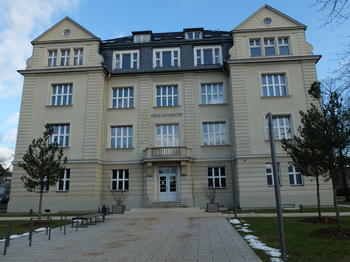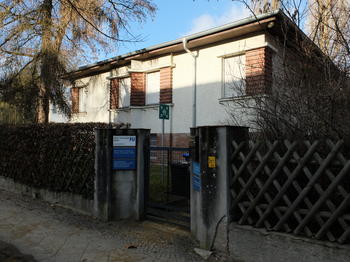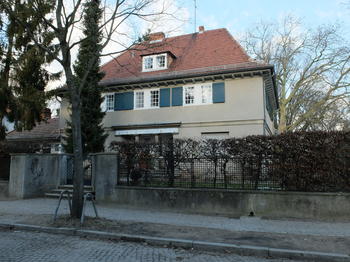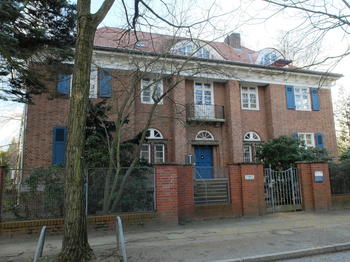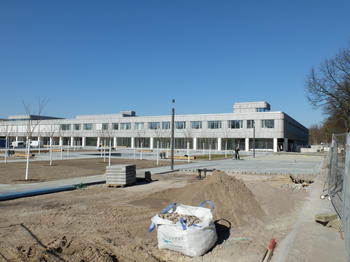A History of the Institute for Ancient Near Eastern Studies
The Freie Universität Berlin was founded on December 4, 1948, a chair for Ancient Near Eastern Philology was established only one year later.
The new chair for Ancient Near Eastern Philology continued the tradition of Assyriological research begun at the former Friedrich-Wilhelms-Universität. Here, the first chair for Assyriology in Germany had been established in 1875, occupied in turn by Eberhard Schrader (1875–1899), Friedrich Delitzsch (1899–1920), and Bruno Meissner (1921–1936). Wolfram von Soden was appointed to the vacant chair in the winter of 1940/41, but was unable to assume the professorship due to the ongoing war. After the end of World War II, Erich Ebeling took up a professorship at the newly established Humboldt-Universität. He was appointed full professor in the winter semester of 1951/52, shortly before his retirement the following year. A successor was never named.
The Freie Universität appointed the philologist and Hittitologist Johannes Friedrich (27.8.1893–12.8.1972) to the newly established chair of the Oriental Institute in 1950. He had previously taught at the Universität Leipzig, where he had also been rector in 1948/49.
The basis for the library in the newly founded seminar at the Freie Universität was provided by private collection of Bruno Meissner, purchased in 1952, who had passed away in Mittenwalde near Berlin in 1947. He had bequeathed his research collection to the Inner Mission of the Evangelical Church, which had in turn donated the library to the Seminar for Ancient Near Eastern Philology and Near Eastern Archeology. Wolfram von Soden took over the lexical notes which Bruno Meissner had compiled for a planned Akkadian dictionary. Ancient Near Eastern Philology, together with Semitics and Arabic Studies, formed a part of the Oriental Institute, located first in the Boltzmannstr. 3 on the second floor, with Near Eastern Archeology on the fourth. In the winter semester of 1954/55, Ancient Near Eastern Studies moved first to a villa in the Garystr. 45 and then, in the summer semester of 1957, to a parterre of a small villa in Faradayweg 15 (the villa of Erna Berger) in Berlin-Dahlem. The Institute for Indo-European Studies occupied the second floor.
Friedrich focused his research and teaching on Hittitology, Hurrian and Urartian Studies, and Northwest Semitic epigraphy. His most important publications include a Hittite grammar (1940, with later editions), a Hittite dictionary, and an edition of the Hittite treaties (1926 and 1930). In 1960, he published his "Hethitisches Keilschrift-Lesebuch", aided by the talents of his then student assistant, Rainer-Michael Boehmer, as a draughtsman, who would later go on to become professor and director of the Baghdad Section of the German Archeological Institute. Friedrich's pioneering studies on Northwest Semitic languages are evidenced in his Phoenician-Punic Grammar (Rome 1951). Later editions were revised and edited by his student Wolgang Röllig, who earned his PhD in Berlin in January of 1960 with a dissertation on "Studies on Selected Phoenician and Punic Inscriptions."
Friedrich's first PhD student in Berlin was Rolf Grobe, who completed his dissertation in 1953 on "Hittite Solar Songs and Their Akkadian Parallels" ("Hethitische Sonnenlieder und ihre akkadischen Parallelen"). One year later, Einar von Schular, who had followed Friedrich to Berlin from Leipzig in 1950, completed his dissertation on "Hittite Instructions for Court and State Officials" ("Hethitische Dienstanweisungen für höhere Hof- und Staatsbeamte." In 1961, after a period as lecturer in Münster under Wolfram von Soden, von Schuler submitted his habilitation in Ancient Near Eastern Philology, on the "Kashkaeans: A Contribution to the Ethnography of Ancient Asia Minor" ("Die Kaškäer. Ein Beitrag zur Ethnographie des alten Kleinasiens") to the Faculty of Ancient Near Eastern Philology of the Freie Universität.
The building and intellectual environment provided ample room for research and teaching as well as for visiting scholars. Students met with ideal conditions in close contact with teaching staff and one another as well as a well-equipped library. The library acquisitions of both seminars were – as they continue to be – integrated into a common resource.
The library of the new institute, which remains one of the best in Europe for research in the field, attracted numerous research fellows funded by Alexander-von-Humboldt and DAAD grants as well as national and international visiting scholars to Berlin.
Following the tragic death of Hans-Jochen Thiel, Karlheinz Kessler assumed the duties of lecturer (Wissenschaftlicher Assistent) in the seminar from the summer semester of 1982 to the winter semester of 1986/87. In May of 1986 he submitted his habilitation on "Uruk: Documents from Private Houses. The Residential Houses West of the Eanna-Tempel" ("Uruk. Urkunden aus Privathäusern. Die Wohnhäuser westlich des Eanna-Tempelbereichs" = Ausgrabungen in Uruk-Warka, Bd. 8, 1991) for the field of Ancient Near Eastern Philology and was soon appointed C3-professor for Ancient Near Eastern Studies at the Universität Erlangen as the successor to Karl Hecker. Kessler's successor in Berlin in the summer semester of 1987 was Stefan Maul, who had just finished his dissertation in Göttingen under the supervision of Rykle Borger on "'Herzberuhigungsklagen'. Die sumerisch-akkadischen Eršahunga-Gebete".
From 1987 to 1987, Kilian Butz (12.3.1943–22.5.1990) worked at the institute as a research associate in a project funded by the Volkswagenstiftung. The goal of the project was to provide transcriptions of ca. 10,000 Old Babylonian legal and administrative texts dating from 20th to 17th century BC. These transcriptions were digitalized in 2009 and incorporated into the online database Archibab (http://www.archibab.fr/).
In 1981, Volkert Haas accepted a newly created position of C2-professor for the history and cultures of the Ancient Near East at the Universität Konstanz. Within a few years after his departure, the seminar was able to elevate his vacant lectureship to a C3-professorship. Soon after the position was advertized in 1988, Volkert Haas was invited again to return to Berlin in the winter semester of 1989. In the following years, he again established Berlin as a center for Hittite cuneiform studies. The countless international students who came to study in Berlin attest to the attractiveness of the university's program in Hittitology in these years.
From Januar of 1990 to December of 1993, Doris Prechel worked at the institute as a research associate under V. Haas to support his work on Hittite religious history. She successfully defended her dissertation on 13th December 1992 with a thesis on the goddess Išhara.
Volkert Haas retired on 30th March 2002. Jörg Klinger assumed the professorship as successor on 1st September 2003.
After Stefan Maul had completed his five-year term as lecturer in 1992, his position was upgraded to a C1-position, through which he was able to continue work at the institute. In the Spring of 1993, Maul accepted the offer of a research fellowship with the Équipe de Mari at the CNRS in Paris, followed by a visiting professorship at the École Pratique des Hautes Études in 1995. Following his habilitation on "Zukunftsbewältigung. Eine Untersuchung altorientalischen Denkens anhand der babylonisch-assyrischen Lösungsrituale (namburbi)" in 1993, he accepted a position as chair of Assyriology in Heidelberg, which had been vacant since Karlheinz Deller's retirement. In 1997, S. Maul was awarded the Leibniz-Prize of the German Research Foundation (DFG).
From 1994–1996, Helmut Freydank, Horst Klengel, and Hans Neumann taught and conducted research at the Seminar of Ancient Near Eastern Studies. In December of 1998, Hans Neumann submitted his habilitation in the department of Ancient Studies for the field of Ancient Near Eastern Philology. While working in the Assur Project in Heidelberg, he remained affiliated with the institute in Berlin as associate before accepting an appointment as professor in Münster (1st October 1999).
Eva Cancik-Kirschbaum was lecturer in the seminar from 1996 to 2001. She had completed her dissertation in Tübingen on "Die mittelassyrischen Briefe aus Tall šeh Hamad/Dur-Katlimmu", and her habilitation in Berlin on 19th July 2002 with a thesis on "Der König von Assur. Zur Organisation politischer Herrschaft in Assyrien vom 14. - 7. Jh. v. Chr." in the Department of History and Cultural Studies at the FU for the field of Ancient Near Eastern Philology. Beginning in 2001, she worked as a research associate in the Heinrich-von-Helmholtz-Zentrum für Kulturtechnik at the Humboldt-Universität. In Spring of 2002, she was visiting professor at the École Pratique des Hautes Études of the University La Sorbonne in Paris. Following Johannes Renger's retirement on 30th of September 2002, Eva Cancik-Kirschbaum accepted an appointment as C4-professor for Ancient Near Eastern Philology and History in the Department of History and Cultural Studies at the FU.
Ariel M. Bagg was hired as lecturer in 2001. He had previously completed his dissertation at the Universität Tübingen with a thesis on "Assyrische Wasserbauten. Landwirtschaftliche Wasserbauten im Kernland Assyriens zwischen der 2. Hälfte des 2. und der 1. Hälfte des 1. Jahrtausends v. Chr." In 2007 he completed his habilitation in Berlin with a thesis on "Die Assyrer und das Westland". The work was completed in close co-operation with the research project 'State Archives of Assyria' at the University of Helsinki. Following his habilitation, he continued to work in Berlin until 2008. Tübingen as well as with the project "State Archives of Assyria" at the University of Helsinki. He continued to teach as an associate in Berlin until 2008.
In 2007, Ariel Bagg was succeeded by Grégory Chambon as university lecturer, who had already served as research associate in the department. He had previously completed his dissertation in Paris on Ancient Near Eastern metrology.
In Fall of 2009, Ingo Schrakamp followed Grégory Chambon as lecturer.
Barbara Böck completed her habilitation on 27th November 2002 with a thesis on "Die Kranken-Massage nach keilschriftlichen Quellen. Beiträge zu Medizin und Magie im Alten Mesopotamien" in the field of Ancient Near Eastern philology.
The administrative office of the institute was led until 1977 by Walter Zaumseil, who had arrived in Berlin together with Johannes Friedrich. He was followed by Margot Winde (1.4.1977–31.7.1984), Ursula Leideck (1.9.1984–30.6.1995), Patricia Löffler (1.1.1995–15.2.1998), Karen Kursave (1.10.1998–31.3.1999), Christina Heynen (1.4.1999–30.9.1999), and Christiane Schierding (1999–31.10.2012). The current administrator is Ute Birk (1.11.2012 to present).
In March of 2015, the Institute left its villa in Hüttenweg 7 to move into the newly constructed campus building in Fabeckstr. 23–25, directly adjacent to the so-called "Rost- und Silberlaube."
Bibliography:
- J. Renger, Die Geschichte der Altorientalistik und der vorderasiatischen Archäologie in Berlin von 1875 bis 1945, in: W. Arenhövel - C. Schreiber (Hrsg.), Berlin in der Antike. Aufsätze, Berlin, 1979, 151 - 192.
- J. Renger, Stichwort "Altorientalische Philologie und Geschichte", DNP 13, 1999, 101 - 113.
